Abstract
Contrary to the extensive amount of research on large wind turbines, substantial analyses of small wind turbines are still rare. In the present study, the wind energy potential of three locations in Poland is analyzed using real wind data from a five-year period and the parameters of the selected turbine model. Appropriate simulations are performed to assess the energy efficiency of the analyzed investments at a coastal, foothill, or lowland site. According to the results, the most favorable location for a small wind turbine is the coastal site (wind zone I). The payback time at this location is approximately 13 years, whereas the payback times at the other two analyzed are more than 3 times longer. The payback periods for the latter locations significantly exceed the estimated lifetime of the wind turbine, ruling out their economic viability. The cost of electricity generation varies greatly, from 0.16 EUR/kWh at the coastal location to 0.71 EUR/kWh at the lowland location. These results provide a reference for developing more efficient solutions, such as the use of a turbine with a shielded rotor, which can increase the power of the turbine by approximately 2.5 times.
1. Introduction
Tremendous advances have occurred in the renewable energy sector in recent decades, among which one of the most important is wind energy. As shown in Figure 1, the rate of growth of global total installed wind power capacity increased annually from 2013 to 2019. Investments in onshore and offshore wind energy worldwide amounted to EUR 128 billion in 2019, compared with EUR 87 billion in 2010, an increase of 38.5% [1]. In Poland, wind energy is the most dynamically developing branch of the renewable energy sector. According to the Energy Regulatory Office (ERO), the total capacity of wind turbines in Poland at the end of 2019 was 5917.243 MW. There are several dozen active wind farms in Poland, mostly located in the northern and central parts of Poland [2]. The ERO regularly reports the installed capacity of each type of renewable energy source in Poland (installations using biogas, biomass, solar energy, wind energy and hydropower). Table 1 shows the installed capacity of all renewable energy source (RES) installations in Poland in 2010, 2015 and 2019; all types increased in installed energy capacity during this period. Further details are shown in Figure 2, which presents the installed capacity for wind power plants over the period 2005–2019. These increases in capacity reflect the expansion of wind installations, which, according to data from the ERO, increased from 981 at the beginning of October 2015 to 1207 by the end of 2019 (single turbines and farms) [3]. Table 1 clearly shows that the highest share of installed capacity at each time point is from wind power plants. In 2019, wind power plants represented nearly 65% of total installed RES capacity in Poland [3,4] and produced 13.9 TWh of electricity, an increase of almost 19.1% compared with the previous year. However, when considered in relation to total domestic electricity generation, wind energy was responsible for only 8.75% of total energy generated [5].
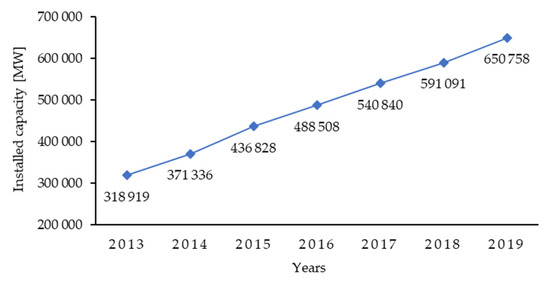
Figure 1.
Total installed wind power capacity in the world [6].

Table 1.
Installed power of renewable energy sources in Poland (years 2010, 2015, 2019) [3].
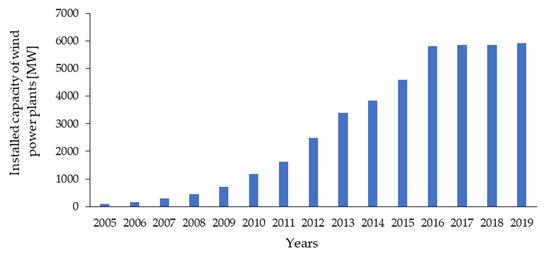
Figure 2.
Installed capacity of wind power plants in Poland, 2005–2019 [3].
1.1. Small Wind Turbines
Within the wind energy sector, small wind turbines (SWTs) are a distinct and separate group of devices. According to the IEC 61400-2 standard, SWTs are characterized by a rotor swept area of less than 200 m2 and rated power below 50 kW [7]. Wind power plants in this category are generally designed for small and individual customers such as households, farms, weather stations, road signals or advertising systems [8]. SWTs are an excellent energy solution for rural areas or poorly industrialized areas where connection to the electricity grid is problematic but winds are strong. Individual consumers are also increasingly investing in SWTs to partially meet household electricity or hot water needs. This is confirmed by data from a report from the Statista portal [9] showing the capacity of small wind turbines in the world from 2010 to 2018. Undoubtedly, the values are rising from year to year, and the interest in the installation of small wind turbines is constantly growing. However, many people who use home wind turbines are disappointed with the actual amount of energy produced, as small wind turbine manufacturers frequently overstate or provide inaccurate information on the generated amount of energy. Such discrepancies reduce public confidence in investing in SWTs and slow the pace of development [10].
Despite some hesitation among consumers, the number of operating SWTs is increasing each year. The growing interest in creating private wind farms may reflect increased awareness of upcoming climate change and the negative aspects of greenhouse gas emissions [11]. By the end of 2014, the total number of SWTs was approximately 945,000 worldwide, an increase of 8.3% compared with the previous year. The highest number of new installed units in 2014 was in China, where the majority of SWTs (approximately 72%) are located [12]. In 2018, the total global installed capacity of SWTs was over 1.73 GW [9].
The growing prevalence of SWTs and the emergence of so-called prosumers within the electricity grid (the smart grid concept) are expected to have major impacts on the way power companies deliver services over the next decade, especially in developing countries [13]. Experts agree that work on the design and architecture of the future grid is as important as efforts to develop the technologies and products, such as SWTs, needed to realize the smart grid vision [14]. Generating electricity using SWTs can be an economically viable solution, but unfortunately the market prices of these solutions are often overstated, especially for developing countries [11].
The publication [8] provides a broad overview of the performance, design, control and manufacturing of small wind turbines. This article shows the presence of research in various aspects of SWT. Among others, experiments were carried out to determine the best spot on the roof of a building to place a wind turbine. Small wind turbines are usually associated with mounting on buildings, but this is not a rule, as they can just as well be installed as stand-alone structures.
SWT profitability is determined by the combination of wind turbine efficiency, cost and reliability. At the preliminary stage of the SWT design process, there is a need for an inexpensive, effective and reliable methodology for estimating these factors when considering design solutions and variants. Given the relatively high cost and time-consuming nature of wind tunnel or natural environment experimental tests [15], the focus should be on modern modelling and simulation tools, which are widely used in fields such as mechanical engineering. Such techniques have already been used to analyze various aspects of SWT design [16,17] and have provided highly accurate results (especially in comparison analyses where the input data for all considered variants are the same) [18]. Of course, the energy produced by small wind turbines cannot always be predicted. This is the case when the turbine is installed close to buildings, where the air flow is disturbed, and in turbulent conditions where reliable measurements are not possible [19,20].
1.2. Motivation
Economic analyses of wind turbines in the literature have adopted a variety of positions but have mainly focused on large wind turbines. Prior to investing in large-scale power engineering projects, major corporations always perform detailed economic analyses, including evaluations of the availability of a convenient location for the construction of a wind farm or the attractiveness of the selected area [2,21,22]. Few such analyses are available for SWTs. SWTs are distinguished by their ability to be installed by individual investors. Given that SWTs are installed close to energy collection points and do not require advanced infrastructure, they may have a real impact on increasing the share of electricity production from RES and, consequently, delaying negative climate change.
The method and time of collection of wind measurements are key factors in assessing the energy efficiency of an investment. Poland has a transitional climate, which indicates the possibility of large differences (deviations) in observations and necessitates long-term observations. Another important aspect is the analysis of multiple measurement locations, which allows comparisons and a more extensive evaluation. The ideal number of locations is not clear due to a lack of relevant publications [23,24]. Usually, one specific measuring station or several locations with a narrow range of tests are analyzed. The present article analyzes measurements in different wind zones at three measurement stations over a period of five years provided by the Institute of Meteorology and Water Management (IMWM) of Poland.
Reliable data are essential for a more accurate depiction of turbine performance. Among previous efforts, sustainable investment in wind farms was examined in Italy [25,26] via a technical-energy-economic feasibility study of wind energy-based systems that took into account the importance of incentives to support wind energy. An in-depth analysis of local climatic conditions and the conditions of the immediate surroundings at the potential investment location is also necessary. In [27], regional heterogeneity in Spain was considered in relation to the aspect of sustainable development and, in particular, the implementation of wind energy. The results indicated that SWTs can work well as a power source for individual electricity consumers, especially in areas where access to the electricity grid is limited. Moreover, combining SWTs with other types of RES (so-called hybrid systems), such as solar power, can provide an uninterrupted power supply year round, regardless of the prevailing weather conditions.
The idea of small wind turbines is very topical in Poland. Last year the National Centre for Research and Development announced the “Grand Challenge: Energy” competition for the design of a small wind turbine. The participants’ task is to design a device capable of capturing energy from the wind and converting it into electricity in the shortest possible time. Small wind turbines have a promising and wide range of applications. They are ideally suited to rural areas where there may be problems with access to the electricity grid, as well as in areas designated mainly for tourism, where electricity is needed to power individual devices and there is no possibility of supplying electricity in other ways, e.g., due to areas protected by the Natura 2000 programme. Therefore, there is a great need for research on small wind turbines as the idea is only just developing in Poland.
In summary, despite the growing literature on SWTs, most studies are based on statistics or forecasts of wind power data, and the use of real wind data to test the effectiveness of SWTs is rare. This article seeks to address this gap by examining the real parameters of SWTs, especially data on actual electricity generation and the profitability of power plant installations. The results will be valuable for economic assessments of wind turbine investments and for determining the real energy potential of SWTs in Poland.
Our contribution includes analysis of real locations in Poland based on current data from meteorological stations of the Institute of Meteorology and Water Management of Poland. The analyses are carried out with a view to maximizing the energy potential of SWTs, which are now strongly promoted in areas with very low levels of industrialization and population density. The innovation of this study is that real parameters and criteria are used to analyze the efficiency and payback period of investments in selected Polish locations. However, the same methods could be used to perform analyses in other countries with low population densities or high energy costs due to environmental conditions. The research carried out in our paper is a great novelty, as we do not know of any studies in the literature that compare the costs of wind resources in terms of installing small wind turbines in different regions of Poland.
2. Materials & Methods
2.1. Subject of the Analysis
In this study, a specific turbine of a selected manufacturer that is recognizable in Poland as well as the European market is used. The company’s scope of activity includes, among others, the production of SWTs, which are commercial products established on the market. The turbine used in the analysis has a horizontal axis of rotation, a rotor diameter of 10.0 m, a nominal power of 12.0 kW and a rotor axis height above the ground of 15.0 m. Typically, the turbines of this manufacturer have blades with a variable angle of attack, multiple brake systems, remote monitoring and active wind direction tracking [28]. Figure 3 provides a general view of the considered SWT and a photograph of the analyzed wind turbine, which is located at the PAN Research Centre for Energy Conversion and Renewable Sources.
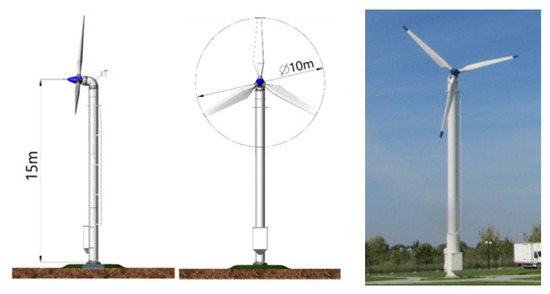
Figure 3.
Analyzed wind turbine, side and front views and photograph [28].
Table 2 provides basic technical data on the selected wind turbine taken directly from the manufacturer. The price of the turbine is expressed in euros based on the average exchange rate of 1 EUR = 4.55 PLN (data as of 4 October 2020). The net price of the turbine includes installation, five-year warranty, warranty service and remote monitoring but does not include transport and external installations required by the power plant, including the inverter, foundation, cable connection from the power plant to the network, transformer station, etc., as they are assessed individually for each location.

Table 2.
Technical specifications of the selected turbine [28].
The cut-in speed is the minimum wind speed at which the turbine starts delivering useful power, while the cut-out speed is the maximum wind speed at which the turbine can produce electric energy. The rated speed is the wind speed at which the nominal power is obtained, which is the maximum output from an electric generator [29]. An important parameter of a wind turbine is the tip speed ratio (TSR), which is the ratio of the linear speed of the turbine blade tip to the wind speed determined by the following formula (Equation (1)):
where ω is the rotational speed, R is the rotor radius and v is the wind speed.
To correctly calculate the TSR of a wind turbine, the same units must be used for all components; the resulting value is dimensionless. The TSR of the turbine considered here is 5.82. This is a relatively low value and indicates that the turbine is sensitive to weak winds and sudden gusts and generates low noise levels [30].
Figure 4 presents the energy characteristics of the analyzed wind turbine as a power output curve, which shows the relationship between the wind speed captured by the rotor and its electrical output. The power curve allows the amount of electricity generated by the turbine to be estimated [31] and is an essential component of wind turbine performance assessment. When the detailed characteristics of wind conditions in a given location are known, the annual electricity production of a turbine can be forecast very accurately on the basis of the power curve, and the economic viability of the investment can be assessed [32]. This type of analysis is at the core of the present paper.

Figure 4.
Power curve of the tested turbine [28].
2.2. Wind Energy Potential in Poland
The best wind conditions in Poland are found on the Baltic Sea coast and the entire coastal zone, but large areas of central Poland and the southern mountain regions are also favorable [33]. The technical potential of wind energy is usually related to the spatial distribution of land of an open character (characterized by a low roughness coefficient and laminar air flow, without interfering objects) [4]. Some wind conditions are not favorable for wind turbines, and zones of air turbulence should be avoided because they can adversely impact performance and weaken the energy potential. The rotor and blades of the turbine should be in the laminar wind stream zone to avoid exposure to turbulence, and the location of each turbine should be selected according to local conditions and wind resources. The weather conditions at a given location should be surveyed continuously for at least one year, and actual data should be recorded, including any deviations.
The wind data used in the study cover a period of 5 years (1 January 2014 to 31 December 2018). The input data were provided by the Institute of Meteorology and Water Management of Poland. The parameter used in the analysis is the wind speed recorded at hourly intervals, expressed in meters per second. The measurements come from three synoptic stations in different parts of Poland: Location 1, Location 2 and Location 3.
Based on many years of meteorological observations (the survey was carried out during the 1971–2000 period), the IMWM has developed a map of the intensity and magnitude of wind currents in Poland. This map divides the country into five zones that differ in attractiveness for wind energy power plants. Zone I, the most advantageous, is located in the coastal zone. Successive zone numbers indicate progressively weaker wind conditions. Figure 5 presents a map of Poland marked with the five wind zones as well as the three locations at which the analyzed measurements were obtained.
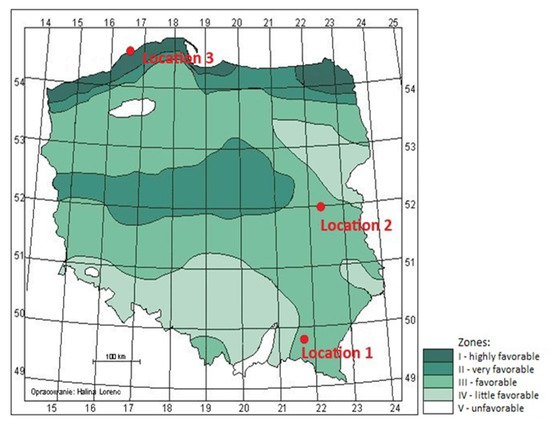
Figure 5.
Wind energy zones in Poland and locations of the measurement stations (source: IMWM–PIB).
Information on the conditions at each measurement location and its immediate surroundings is important for real observations and evaluating the correctness of the measurements. The synoptic station at Location 1 is located on the outskirts of a city in the area of the Carpathian Foothills at 329.0 m above sea level and is situated in wind zone III. It is located on a hill, approximately 70 m above the bottom of the river that flows through the city. The surroundings are mainly farmlands and meadows. The nearest elevation is to the northeast (approximately 4 km)-Odrzykoń Castle. To the south and north are the Carpathian Foothills, which are approximately 20 to 50 km away. The measurement device of the station is located at a height of 10.0 m. The station at Location 2 is located in the strip of large valleys in the northern part of the South Podlasie Lowland (lowland area), 152.0 m above sea level. It is also part of wind zone III, and the height of the wind gauge is 12.0 m. The station is located in the northwestern part of a city in a completely open area. Immediately to the north, there are farmlands and wastelands, and at a further distance of 45.0 m there are single trees; towards the east there are small clusters of trees and buildings. There is a street to the south, and farther on there are allotment gardens. From west to north there are wastelands and farmlands. The station located at Location 3 is in a coastal area, 3.0 m above sea level. This station is located in the most favorable area, wind zone I. The meteorological measurement station is located on a small sandy dune by the city beach, at the mouth of the river, near the harbor channel. The station is located in a lighthouse, approximately 60 m from the Baltic Sea coast; the distance from the coastline depends on the sea level at the given moment. The wind gauge is located at a height of 23.0 m. The same model of measurement device is used at all three stations: a WINDCAP WS425 (Vaisala Oyj, Helsinki, Finland). The device documentation indicates that the wind speed measurement accuracy is ±0.135 m/s and the wind direction accuracy is ±2° [34]. All three synoptic stations meet the location requirements recommended by the World Meteorological Organization (WMO).
In the first stage of the study, wind speeds recorded during the 2014–2018 period were analyzed for the three locations. The raw data received from IMWM is in the form of hourly measurements of wind speeds. Average wind speeds for each month across all years studied were calculated separately for each location. Figure 6 presents the results to facilitate the analysis of trends, differences and relationships. A trend of windiness can be observed across all 3 locations: windiness is usually higher in the autumn-winter period than in the spring-summer period, and winter is the windiest season. The graphs also show a clear difference in monthly electricity generation, as the vast majority of electricity is generated during the windy winter months. All necessary maintenance operations as well as routine checks should be carried out during the calm (least windy) summer months. Seasonal discrepancies in electrical generation can cause problems with continuous supply [35].
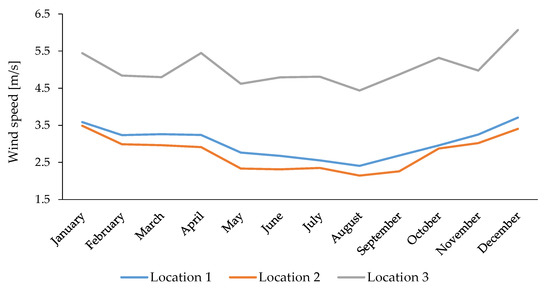
Figure 6.
Distribution of mean monthly wind speeds across the period 2014–2018 for the three locations.
Figure 7 presents the monthly wind speeds averaged among the three locations for each year analyzed. The raw data are provided in Appendix A and Appendix B. Each year is different; no two diagrams are identical. Although the individual diagrams intersect and even overlap, the discrepancies are rather significant and obvious.
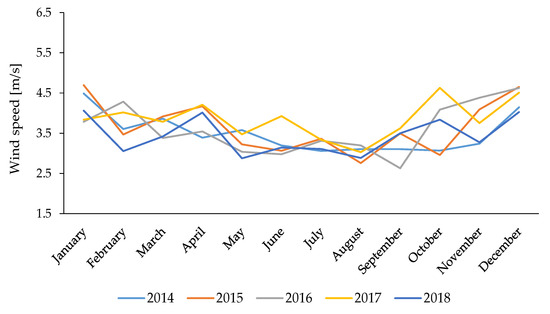
Figure 7.
Distribution of average monthly wind speed among the three locations for the period 2014–2018.
To more accurately depict real achievable wind speeds in Poland, histograms were prepared to illustrate how frequently specific wind speeds occur at each location. The histograms were created with instantaneous speeds from raw data recorded at an hourly interval. The histograms in Figure 8 are for 2018 and clearly differ when Location 3 is compared with Locations 1 and 2. It can be seen from the graphs that throughout the study period, wind speeds in Location 1 and 2 mostly reached about 2 m/s, and for Location 3-about 4 m/s. Wind speed analysis is the basis for calculating the annual electricity production in a given location by a specific wind turbine in this study.
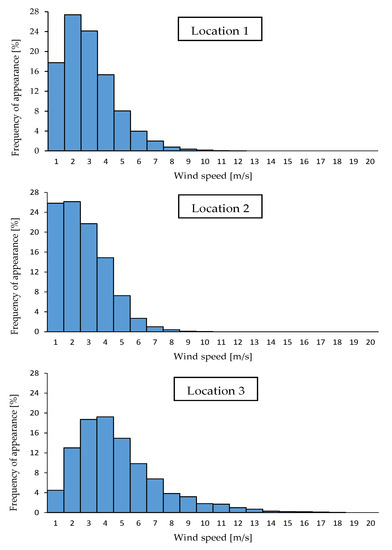
Figure 8.
Wind speed distribution in 2018.
Figure 9 shows the distribution of wind direction at the three locations in 2018. At Location 1, there were three dominant wind directions with similar frequencies of approximately 11%: northwestern, eastern and southern. At Location 2, the wind directions were less diverse, with no wind direction exceeding 10%, but were most often from the north and southeast. At the coastal Location 3, the most frequent wind direction was southern, with a frequency of 14.62%, reflecting the strong influence of the sea breeze. The average annual wind speeds for each location are shown in Table 3 and Figure 10. At each location, the average wind conditions were similar throughout the study period, with slightly higher wind speeds in 2017. Compared with the other two stations, Location 3 clearly features much more favorable wind conditions, consistent with its location in Poland’s wind zone I. Locations 1 and 2 are located in wind zone III and thus exhibit similar wind speeds and similar disparities compared with Location 3.
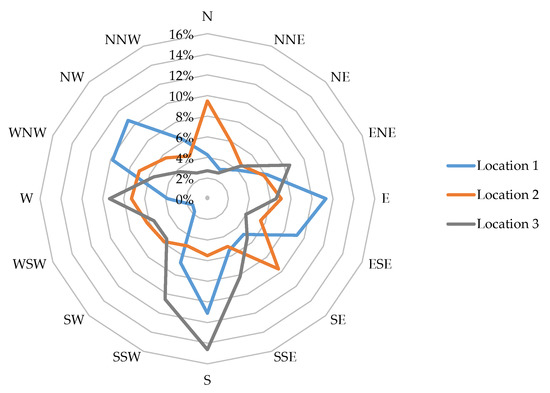
Figure 9.
Wind frequency distribution at each location in 2018.

Table 3.
Average wind speeds (m/s) at the tested locations between 2014 and 2018.
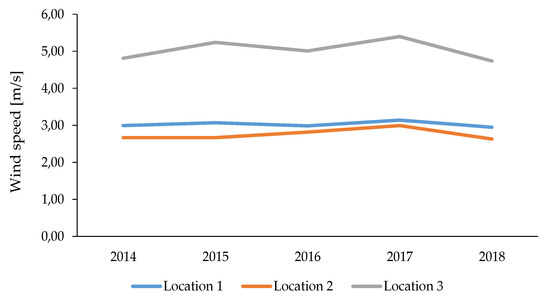
Figure 10.
Average wind speeds at the tested locations in 2014–2018.
2.3. Economic Analysis
In the second stage of the study, the annual energy production (AEP) was calculated for each surveyed year for each station based on the wind characteristics, namely individual wind speeds and their frequency in a given period, and parameters from the turbine power curves for specific wind speeds. The AEP is calculated by successively multiplying the power for each wind speed from the turbine power curve by the measured wind frequency distribution and the number of hours per year [36]. For calculating the AEP, a fixed operating period was assumed, i.e., periods out of operation (e.g., due to repair and maintenance of equipment) were not taken into account. The results are summarized in Table 4 and illustrated in Figure 11.

Table 4.
Simulation results for energy production at the tested locations between 2014 and 2018.
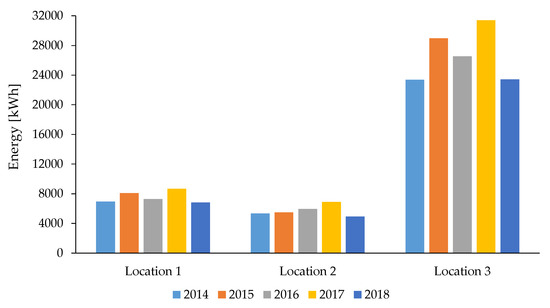
Figure 11.
Energy yield comparison among the three locations.
The main object of the analysis is the distribution of wind speeds over the year. On its basis, the time of occurrence of winds with specific speeds during the year and, consequently, the energy production of a wind power plant is estimated. After dividing the entire range of measured values into intervals, the measured data are grouped, allowing for a number of classes ni to be determined, i.e., the number of wind speed occurrences in each i-th class. Related to the notion of abundance is the frequency fi, defined as the ratio of the abundance to the total number of measured data N (Equation (2)):
The time ti for one year (T–basic measurement period: one year), of the wind at a given speed in the i-th interval (Equation (3)):
To calculate the energy produced by the power plant in one year in the next i-th class interval , multiply the value ti by the power of the power plant expressed by the corresponding turbine power curve P (Equation (4)):
The total energy produced per year by the power plant will be the sum of the component energies of all class intervals c (Equation (5)):
In order to obtain the AEP, it is necessary to add up the energies produced Ei, considering the five-year test period k [37] (Equation (6)):
In the next step, a number of calculations were performed for which the cost of electricity in Poland was required. The data were taken from Eurostat’s statistical database: the average retail electricity price in 2019 for households was 0.1343 EUR/kWh, and the market price was 0.1233 EUR/kWh [38]; prices quoted include all taxes and fees. In Poland, prosumers generating electricity for their own use sell excess produced energy to the grid, necessitating the use of two different electricity prices in the calculations. According to the Central Statistical Office, the average household electricity consumption was 3797.0 kWh in Poland in 2018 [39]. This value was used with the average retail electricity price to calculate the price of 1.0 kWh for households; for the rest of the annual energy production, the market price was used. The cost of wind turbine construction (investment costs) obtained directly from the manufacturer was estimated at EUR 38,022. The cost of energy (COE) was also calculated for each considered case. Finally, the return of investment in the form of simple payback time (SPBT) was calculated for the three sites. The results of the calculations are shown in Table 5.

Table 5.
Economic comparison of selected locations–simulation results.
COE is a metric used to assess the costs of electricity generation [40]. For one year of turbine operation, the formula for COE is as follows (Equation (7)):
where COE is the cost of energy [EUR/kWh], I is investment wind turbine costs [EUR], AEP is annual energy production [kWh], TOM is total yearly operation and maintenance costs [EUR], and CRF is the capital recovery factor. CRF is the yearly interest [%/year], which depends on interest rate i and economic lifetime n (Equation (8)):
Data related to the costs of maintenance and operation of SWTs are very difficult to obtain, as the small companies or individuals operating SWTs do not publish such information or may not even record it. This lack of data hinders detailed and accurate economic analyses of SWTs. Values of parameters for which data were not available were therefore taken from the relevant literature concerning SWTs. The CRF value is derived from an article by G. J. W. van Bussel [40]. If we assume an interest rate of 6% per year and an economic lifetime of the turbine of 15 years, then CRF will be 0.103. We do not yet have information on the operating costs of the investment, so we use the claim by K. R. Rao [36] that the estimated TOM is 0.015 euros per 1.0 kWh of wind energy produced over the entire life of the turbine. Subsequently, the AEP was multiplied by the average retail electricity price according to Equation (4). The product is the monetary savings resulting from a year of operation of the SWT at the specific location (Equation (9)):
where s is the savings in one year and c is the price of 1.0 kWh; c = 0.1343 EUR/kWh and 0.1233 EUR/kWh. The last and key stage was the calculation of SPBT. SPBT describes the profitability of an investment in a simplified manner, as it does not take into account the entire lifetime of the project and the operating costs [41]. However, to obtain a more accurate assessment, we modified the formula by deducting the operating and maintenance costs of the turbine from the monetary savings earned in one year from the renewable energy system. Thus, in this study, SPBT is determined by the following formula (Equation (10)):
The result is the time (in years) after which the amount of money saved from the use of a small wind turbine will exceed the amount of funds invested in the project. To assess economic efficiency, appropriate calculations were used to determine whether the investment is profitable and after what period of use the wind power plant will start to generate profit.
3. Results
The results of the simulations of energy production at the three selected locations for the period 2014–2018 are shown in Table 4 and Figure 11. Based on the calculated total energy produced over a period of five years, Location 3 is definitely the most effective location, with more than four times greater energy production compared with either of the other two locations.
Table 5 presents the economic parameters associated with the results of the simulation studies; the key indicator is SPBT. A wide range of investment payback periods is obtained, highlighting the importance of a proper, in-depth analysis of location in the preliminary design of SWT installations and before the start of the investment. The table also shows the value of the capacity factor, calculated for the five-year study period for each case. It provides information about the performance of the turbine and the utilisation of its potential under the given conditions. The value obtained for Location 3 is optimum and indicates relatively good adaptation of the turbine to the wind conditions. However, for Locations 1 and 2 the indicator reached a very low level and it can be concluded that the selected turbine is not suitable to use under these conditions.
Figure 12 shows the trends in the costs of electricity generation over the period 2014–2018 at the three analyzed locations. Costs vary greatly depending on the location of the SWT, and Location 3 is clearly the most cost-effective. The cost is lowest at Location 3 for the five-year period analyzed, with an average cost of EUR 0.16/kWh, in contrast to average costs of 0.53 EUR/kWh and 0.70 EUR/kWh at Locations 1 and 2, respectively. The analysis shows that Location 2 is the most expensive-this can already be deduced from the value of the AEP index, which is the lowest of the three cases. We have the same cost assumptions for all locations, so if the least amount of electricity was produced in Location 2 during the year, then we get the highest cost of electricity generation per kWh.
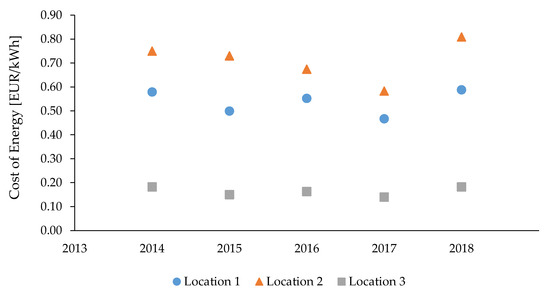
Figure 12.
Unit cost of energy production at the three locations in 2014–2018.
4. Discussion
When choosing to invest in an alternative source of energy for a household, the most important consideration is the economic aspect. The most desirable outcome is return of investment, followed by the time after which the investment will start to yield a profit. In an amendment to the RES Act, the Polish Ministry of Energy (currently the Ministry of State Assets) assumes an average rate of return on prosumer PV installations of 10 years [42]. Among the locations analyzed in this study, the return of investment for Location 3 is closest to that of PV panels. However, a period of 10 years before providing profit is still a long period of return of investment for the ordinary prosumer. If earning money was the main objective, the construction of a small wind power plant is not the best option. On the other hand, if the aim of the investment is to reduce electricity bills and CO2 emissions, in the long run, an SWT is a very beneficial solution for a household.
However, the investment return times are not satisfactory for all analyzed locations, which should motivate a search for more efficient solutions. One such solution is a turbine with a shrouded rotor (diffuser). Despite extensive study, shrouded turbines are not yet widely used due to their complexity and high design and manufacturing costs. The diffuser acts as a wind gathering and accelerating device, allowing the turbine to achieve higher aerodynamic efficiency than allowed by the Betz limit. Reference [43] describes the occurring dependencies related to the Betz limit in more detail. Subsequent work has found that it is possible to increase the efficiency coefficient by approximately 2.5 times [44,45], which would increase the power of the turbine by the same amount. Using advanced numerical methods to significantly improve turbine performance and reduce turbine costs compared with existing designs, a 1:2 scale prototype of an SWT with a diffuser optimized for wind conditions typical of Poland has been constructed. The turbine’s aerodynamics were optimized based on wind tunnel tests and reliable weather data obtained from the Weather Research & Forecasting (WRF) numerical model [15,46]. These findings were used in the present study to calculate the possible increase in efficiency of an SWT due to rotor shielding and the expected payback period, which is shown in the last column of Table 5. However, this assessment does not take into account the costs resulting from the complexity of the new design, such as the need to redesign the hub structure, manufacture the diffuser or add or change the support structures, and thus is not fully reliable.
The basic knowledge necessary for deciding to invest in a wind turbine in a given area is local wind energy resources. The results of the present study emphasize the potential for large differences in average annual wind speeds among measurement points and hence the importance of measurements of wind characteristics for decision-making. Wind potential clearly differed not only among the three selected locations but also among the analyzed years, indicating that long-term wind measurements are necessary to avoid seasonality. The recorded measurements and calculations can also be used in further economic analyses.
As shown in Figure 12, the unit cost of electricity generation clearly differs among the locations studied. This is an important parameter for assessing the energy efficiency of a turbine. The results show that the most favorable location for the installation of an SWT is Location 3, which is located in the coastal strip (wind zone I). The estimated service life of a wind turbine is usually 20–25 years [47]. Similar data are not available for SWTs, and therefore we use this estimated service life. According to the calculations, the return of the planned investment at Location 3 in the Baltic Sea will occur after approximately 13 years. This result is satisfactory compared with the cost-effectiveness of the other locations. The investment at Location 1 in the Carpathian Foothills will pay for itself after a period over 3 times longer (44 years and 2 months), and the least profitable place to build a wind turbine is Location 2, located in the lowlands of Poland, as the return of investment costs will not occur until 57 years and 5 months. The payback periods obtained for Location 1 and Location 2 significantly exceed the estimated wind turbine lifetime. Due to the poor wind conditions at these two locations, investments in SWTs in these areas are pointless, as the costs incurred during wind farm installation will far exceed the expected profits and payback time. Accordingly, these locations can be excluded from investment based on a lack of economic viability. The next stage of this research will be to analyze the operating costs of SWTs in cooperation with potential turbine manufacturers. The values from the literature used here will be replaced with actual price data of individual elements and exploitation stages in order to complement and extend the present overview of SWTs.
5. Conclusions
Based on the results of this analysis, the following conclusions can be drawn:
- The wind characteristics in the analysed locations have a similar windiness trend, as the windiness in autumn-winter period is higher than in spring-winter period in each location.
- The unit cost of electricity generation is clearly different in each location studied in different regions of Poland. This proves the necessity of thorough verification of the surroundings before investing in a small wind turbine.
- The most favourable location for SWT installation in Poland is Location 3, which is located in the coastal belt (I wind zone).
- The conducted analysis gives an overview of the costs of wind resources in different parts of Poland, but it is not truly complete as the authors did not have all the required data for calculations, and therefore they partly used assumptions from the literature.
- Current SWTs are promising solutions for use in sparsely populated areas where there is no access to electricity from the distribution grid.
- The addition to SWTs of equipment such as diffusers to tunnel the rotor could increase SWT efficiency and promote further growth of the wind energy industry. Rotor tunnelling can also ensure efficient wind turbine operation, even in areas with less than ideal wind conditions.
Author Contributions
Conceptualization, J.Z. and J.M.; methodology, K.D. and J.M.; formal analysis, J.M. and K.D.; investigation, J.Z and K.D.; data curation. J.Z.; resources, J.Z. and J.M.; visualization, J.Z. and K.D.; writing—original draft preparation, J.Z.; writing—review and editing, J.Z., J.M. and K.D.; supervision, J.M. and K.D.; project administration, J.M.; funding acquisition, J.M. All authors have read and agreed to the published version of the manuscript.
Funding
This work was financed/co-financed by Military University of Technology under research project UGB 878/2021.
Institutional Review Board Statement
Not applicable.
Informed Consent Statement
Not applicable.
Data Availability Statement
Not applicable.
Acknowledgments
The authors acknowledge the Institute of Meteorology and Water Management for providing the wind data used in the study.
Conflicts of Interest
The authors declare no conflict of interest. The funders had no role in the design of the study; in the collection, analysis, or interpretation of the data; in the writing of the manuscript; or in the decision to publish the results.
Appendix A

Table A1.
Distribution of mean monthly wind speeds from 2014 to 2018 at the three locations.
Table A1.
Distribution of mean monthly wind speeds from 2014 to 2018 at the three locations.
| Wind Speed [m/s] | ||||||||||||
|---|---|---|---|---|---|---|---|---|---|---|---|---|
| January | February | March | April | May | June | July | August | September | October | November | December | |
| Location 1 | 3.59 | 3.23 | 3.26 | 3.24 | 2.77 | 2.68 | 2.55 | 2.40 | 2.69 | 2.96 | 3.25 | 3.71 |
| Location 2 | 3.49 | 2.99 | 2.96 | 2.91 | 2.33 | 2.31 | 2.35 | 2.14 | 2.26 | 2.87 | 3.02 | 3.40 |
| Location 3 | 5.44 | 4.84 | 4.80 | 5.45 | 4.62 | 4.79 | 4.81 | 4.44 | 4.87 | 5.32 | 4.98 | 6.07 |
Appendix B

Table A2.
Distribution of average monthly wind speed at the three locations for the period 2014–2018.
Table A2.
Distribution of average monthly wind speed at the three locations for the period 2014–2018.
| Wind Speed [m/s] | ||||||||||||
|---|---|---|---|---|---|---|---|---|---|---|---|---|
| January | February | March | April | May | June | July | August | September | October | November | December | |
| Location 1 | 3.92 | 3.32 | 3.37 | 2.82 | 3.02 | 2.74 | 2.32 | 2.40 | 2.43 | 2.67 | 3.28 | 3.60 |
| Location 2 | 4.25 | 2.89 | 2.98 | 2.49 | 2.52 | 2.03 | 2.28 | 2.13 | 2.15 | 2.38 | 2.82 | 3.05 |
| Location 3 | 5.28 | 4.61 | 5.24 | 4.86 | 5.20 | 4.80 | 4.58 | 4.78 | 4.75 | 4.15 | 3.62 | 5.78 |
| 2014 | 4.49 | 3.61 | 3.86 | 3.39 | 3.58 | 3.19 | 3.06 | 3.11 | 3.11 | 3.07 | 3.24 | 4.14 |
| Location 1 | 3.97 | 2.90 | 3.44 | 3.41 | 2.74 | 2.54 | 2.55 | 2.34 | 3.13 | 2.73 | 3.16 | 3.90 |
| Location 2 | 3.60 | 2.50 | 3.06 | 2.83 | 2.00 | 1.94 | 2.26 | 2.03 | 2.27 | 2.46 | 3.26 | 3.71 |
| Location 3 | 6.52 | 5.01 | 5.26 | 6.27 | 4.94 | 4.71 | 5.29 | 3.91 | 5.08 | 3.70 | 5.86 | 6.35 |
| 2015 | 4.70 | 3.47 | 3.92 | 4.17 | 3.23 | 3.07 | 3.36 | 2.76 | 3.49 | 2.96 | 4.09 | 4.65 |
| Location 1 | 3.34 | 3.86 | 2.79 | 2.93 | 2.63 | 2.47 | 2.74 | 2.66 | 2.03 | 3.04 | 3.78 | 3.52 |
| Location 2 | 3.08 | 3.59 | 2.94 | 2.68 | 2.20 | 2.39 | 2.54 | 2.26 | 1.82 | 3.36 | 3.34 | 3.64 |
| Location 3 | 4.94 | 5.41 | 4.42 | 5.03 | 4.29 | 4.07 | 4.65 | 4.67 | 4.04 | 5.86 | 6.02 | 6.71 |
| 2016 | 3.78 | 4.29 | 3.38 | 3.55 | 3.04 | 2.98 | 3.31 | 3.20 | 2.63 | 4.09 | 4.38 | 4.62 |
| Location 1 | 2.94 | 3.51 | 3.53 | 3.45 | 2.80 | 3.20 | 2.58 | 2.53 | 3.12 | 3.31 | 2.98 | 3.80 |
| Location 2 | 3.05 | 3.50 | 3.11 | 3.28 | 2.58 | 2.97 | 2.36 | 2.31 | 2.79 | 3.55 | 2.91 | 3.56 |
| Location 3 | 5.52 | 5.06 | 4.72 | 5.91 | 5.04 | 5.60 | 5.08 | 4.25 | 4.96 | 7.02 | 5.37 | 6.18 |
| 2017 | 3.84 | 4.02 | 3.79 | 4.21 | 3.48 | 3.92 | 3.34 | 3.03 | 3.62 | 4.63 | 3.75 | 4.51 |
| Location 1 | 3.76 | 2.58 | 3.17 | 3.60 | 2.63 | 2.42 | 2.58 | 2.09 | 2.71 | 3.04 | 3.05 | 3.72 |
| Location 2 | 3.47 | 2.47 | 2.74 | 3.28 | 2.37 | 2.23 | 2.31 | 1.98 | 2.27 | 2.62 | 2.76 | 3.05 |
| Location 3 | 4.96 | 4.12 | 4.35 | 5.18 | 3.64 | 4.78 | 4.44 | 4.59 | 5.53 | 5.85 | 4.01 | 5.32 |
| 2018 | 4.06 | 3.06 | 3.42 | 4.02 | 2.88 | 3.14 | 3.11 | 2.89 | 3.50 | 3.84 | 3.28 | 4.03 |
References
- Lee, J.; Zhao, F. Global Wind Report; Global Wind Energy Council: Brussels, Belgium, 2019. [Google Scholar]
- Gnatowska, R.; Was, A. Wind Energy in Poland—Economic Analysis of Wind Farm. In Proceedings of the E3S Web of Conferences, EDP Sciences, Cracow, Poland, 15 March 2017; Volume 14. [Google Scholar]
- Moc Zainstalowana (MW)—Potencjał Krajowy OZE w Liczbach—Urząd Regulacji Energetyki. Available online: https://www.ure.gov.pl/pl/oze/potencjal-krajowy-oze/5753,Moc-zainstalowana-MW.html (accessed on 8 February 2021).
- Igliński, B.; Iglińska, A.; Koziński, G.; Skrzatek, M.; Buczkowski, R. Wind Energy in Poland—History, Current State, Surveys, Renewable Energy Sources Act, SWOT Analysis. Renew. Sustain. Energy Rev. 2016, 64, 19–33. [Google Scholar] [CrossRef]
- Orkan Sabrina Nakręcił Polskie Wiatraki. Rekordowa Generacja|GRAMwZIELONE.Pl. Available online: https://www.gramwzielone.pl/energia-wiatrowa/102441/orkan-sabina-nakrecil-polskie-wiatraki-rekordowa-generacja (accessed on 10 February 2021).
- Global Wind Power Statistics—Wind Energy International Platform. Available online: https://library.wwindea.org/global-statistics/ (accessed on 8 February 2021).
- International Standard IEC 61400-2. Wind Turbines-Part 2: Small Wind Turbines; International Electrotechnical Commission: Geneva, Switzerland, 2013; ISBN 9782832212844. [Google Scholar]
- Tummala, A.; Velamati, R.K.; Sinha, D.K.; Indraja, V.; Krishna, V.H. A Review on Small Scale Wind Turbines. Renew. Sustain. Energy Rev. 2016, 56, 1351–1371. [Google Scholar] [CrossRef]
- Sonnichsen, N. Capacity of Small Wind Turbines Worldwide 2018|Statista. Available online: https://www.statista.com/statistics/269885/capacity-of-small-wind-turbines-worldwide/ (accessed on 10 February 2021).
- Bukala, J.; Damaziak, K.; Kroszczynski, K.; Krzeszowiec, M.; Malachowski, J. Investigation of Parameters Influencing the Efficiency of Small Wind Turbines. J. Wind Eng. Ind. Aerodyn. 2015, 146, 29–38. [Google Scholar] [CrossRef]
- Bukala, J.; Damaziak, K.; Karimi, H.R.; Kroszczynski, K.; Krzeszowiec, M.; Malachowski, J. Modern Small Wind Turbine Design Solutions Comparison in Terms of Estimated Cost to Energy Output Ratio. Renew. Energy 2015, 83, 1166–1173. [Google Scholar] [CrossRef]
- Pitteloud, J.-D.; Gsänger, S. Small Wind World Report; World Wind Energy Association: Bonn, Germany, 2016. [Google Scholar]
- Terrapon-Pfaff, J.; Dienst, C.; König, J.; Ortiz, W. A Cross-Sectional Review: Impacts and Sustainability of Small-Scale Renewable Energy Projects in Developing Countries. Renew. Sustain. Energy Rev. 2014, 40, 1–10. [Google Scholar] [CrossRef] [Green Version]
- Grijalva, S.; Tariq, M.U. Prosumer-Based Smart Grid Architecture Enables a Flat, Sustainable Electricity Industry. In Proceedings of the IEEE PES Innovative Smart Grid Technologies Conference Europe, ISGT Europe, Anaheim, CA, USA, 17–19 January 2011. [Google Scholar]
- Olasek, K.; Karczewski, M.; Lipian, M.; Wiklak, P.; Józwik, K. Wind Tunnel Experimental Investigations of a Diffuser Augmented Wind Turbine Model. Int. J. Numer. Methods Heat Fluid Flow 2016, 26, 2033–2047. [Google Scholar] [CrossRef]
- Bukala, J.; Damaziak, K.; Karimi, H.R.; Malachowski, J. Aero-Elastic Coupled Numerical Analysis of Small Wind Turbine-Generator Modelling. Wind Struct. Int. J. 2016, 23, 577–594. [Google Scholar] [CrossRef]
- Bukala, J.; Damaziak, K.; Karimi, H.R.; Malachowski, J.; Robbersmyr, K.G. Evolutionary Computing Methodology for Small Wind Turbine Supporting Structures. Int. J. Adv. Manuf. Technol. 2019, 100, 2741–2752. [Google Scholar] [CrossRef] [Green Version]
- Kim, K.; Lim, C.; Oh, Y.O.; Kwon, I.; Yoo, N.; Paek, I. Time-Domain Dynamic Simulation of a Wind Turbine Including Yaw Motion for Power Prediction. Int. J. Precis. Eng. Manuf. 2014, 15, 2199–2203. [Google Scholar] [CrossRef]
- Pagnini, L.C.; Burlando, M.; Repetto, M.P. Experimental power curve of small-size wind turbines in turbulent urban environment. Appl. Energy 2019, 154, 112–121. [Google Scholar] [CrossRef]
- Vita, G.; Šarkić-Glumac, A.; Hemida, H.; Salvadori, S.; Baniotopoulos, C. On the Wind Energy Resource above High-Rise Buildings. Energies 2020, 13, 3641. [Google Scholar] [CrossRef]
- Sakka, E.G.; Bilionis, D.V.; Vamvatsikos, D.; Gantes, C.J. Onshore Wind Farm Siting Prioritization Based on Investment Profitability for Greece. Renew. Energy 2020, 146, 2827–2839. [Google Scholar] [CrossRef]
- Ayodele, T.R.; Ogunjuyigbe, A.S.O.; Amusan, T.O. Wind Power Utilization Assessment and Economic Analysis of Wind Turbines across Fifteen Locations in the Six Geographical Zones of Nigeria. J. Clean. Prod. 2016, 129, 341–349. [Google Scholar] [CrossRef]
- Grieser, B.; Sunak, Y.; Madlener, R. Economics of Small Wind Turbines in Urban Settings: An Empirical Investigation for Germany. Renew. Energy 2015, 78, 334–350. [Google Scholar] [CrossRef]
- Rodriguez-Hernandez, O.; Martinez, M.; Lopez-Villalobos, C.; Garcia, H.; Campos-Amezcua, R. Techno-Economic Feasibility Study of Small Wind Turbines in the Valley of Mexico Metropolitan Area. Energies 2019, 12, 890. [Google Scholar] [CrossRef] [Green Version]
- Campisi, D.; Gitto, S.; Morea, D. Effectiveness of Incentives for Wind Energy: Models and Empirical Evidences from an Italian Case Study. J. Sustain. Sci. Manag. 2016, 11, 39–48. [Google Scholar]
- Morea, D.; Poggi, L.A. An Innovative Model for the Sustainability of Investments in the Wind Energy Sector: The Use of Green Sukuk in an Italian Case Study. Int. J. Energy Econ. Policy 2017, 7, 53–60. [Google Scholar]
- Gutiérrez-Pedrero, M.-J.; Ruiz-Fuensanta, M.J.; Tarancón, M.-Á. Regional Factors Driving the Deployment of Wind Energy in Spain. Energies 2020, 13, 3590. [Google Scholar] [CrossRef]
- DR ZĄBER ZEFIR. Available online: http://zaber.com.pl/zefir/ (accessed on 2 February 2021).
- Lydia, M.; Kumar, S.S.; Selvakumar, A.I.; Prem Kumar, G.E. A Comprehensive Review on Wind Turbine Power Curve Modeling Techniques. Renew. Sustain. Energy Rev. 2014, 30, 452–460. [Google Scholar] [CrossRef]
- Bakırcı, M.; Yılmaz, S. Theoretical and Computational Investigations of the Optimal Tip-Speed Ratio of Horizontal-Axis Wind Turbines. Eng. Sci. Technol. Int. J. 2018, 21, 1128–1142. [Google Scholar] [CrossRef]
- Karczewski, M.; Baszczynski, P.; Wiklak, P.; Sobczak, K.; Jozwik, K. Economic Analysis of Small Wind Turbines. J. Mach. Eng. 2017, 17, 112–123. [Google Scholar]
- Saint-Drenan, Y.M.; Besseau, R.; Jansen, M.; Staffell, I.; Troccoli, A.; Dubus, L.; Schmidt, J.; Gruber, K.; Simões, S.G.; Heier, S. A Parametric Model for Wind Turbine Power Curves Incorporating Environmental Conditions. Renew. Energy 2020, 157, 754–768. [Google Scholar] [CrossRef]
- Brzezińska-Rawa, A.; Goździewicz-Biechońska, J. Recent Developments in the Wind Energy Sector in Poland. Renew. Sustain. Energy Rev. 2014, 38, 79–87. [Google Scholar] [CrossRef]
- USER’S GUIDE Vaisala WINDCAP® Ultrasonic Wind Sensor WS425; Vaisala Oyj: Helsinki, Finland, 2010.
- Bukala, J.; Damaziak, K.; Kroszczynski, K.; Malachowski, J.; Szafranski, T.; Tomaszewski, M.; Karimi, H.R.; Jozwik, K.; Karczewski, M.; Sobczak, K. Small Wind Turbines: Specification, Design, and Economic Evaluation. In Wind Turbines—Design, Control and Applications; InTech: Rijeka, Croatia, 2016; pp. 73–93. [Google Scholar]
- Rao, K.R. Wind Energy Economics in Wind Energy for Power Generation; Springer: Cham, Switzerland, 2019; pp. 427–701. ISBN 9783319751344. [Google Scholar]
- Michalak, P. Ocena zasobów energii wiatru na potrzeby małej energetyki wiatrowej. Elektrotechnika i Elektron. 2009, 28, 14–19. [Google Scholar]
- Eurostat—Data Explorer. Available online: https://appsso.eurostat.ec.europa.eu/nui/show.do?dataset=nrg_pc_205&lang=en (accessed on 23 February 2021).
- Statistical Analyses. Energy Consumption in Households in 2018; Główny Urząd Statystyczny: Warsaw, Poland, 2019. [Google Scholar]
- Bussel, G.J.W. Electricity Generation with Small Wind Turbines in Renewable Energy Systems; Springer: New York, NY, USA, 2013; pp. 696–727. ISBN 9781461458203. [Google Scholar]
- Boczar, T. Wykorzystanie Energii Wiatru; PAK: Warszawa, Poland, 2010; ISBN 978-83-926319-6-5. [Google Scholar]
- Uniewicz, C. 10 Czy 30 Lat? Jaka Jest Rzeczywista Stopa Zwrotu Mikroinstalacji?|GRAMwZIELONE.Pl. Available online: https://www.gramwzielone.pl/energia-sloneczna/21908/10-czy-30-lat-jaka-jest-rzeczywista-stopa-zwrotu-mikroinstalacji (accessed on 25 February 2021).
- Jiang, H.; Li, Y.; Cheng, Z. Performances of Ideal Wind Turbine. Renew. Energy 2015, 83, 658–662. [Google Scholar] [CrossRef]
- Karczewski, M.; Sobczak, K.; Lipian, M.; Jozwik, K. Numerical and experimental tools for small wind turbine load analysis. In Structural Control and Fault Detection of Wind Turbine Systems; The Institution of Engineering and Technology: London, UK, 2018; pp. 45–79. ISBN 9781785613944. [Google Scholar]
- STOW Project Main Site. Available online: http://www.stow.wat.edu.pl/ (accessed on 25 February 2021).
- Lipian, M.; Dobrev, I.; Karczewski, M.; Massouh, F.; Jozwik, K. Small Wind Turbine Augmentation: Experimental Investigations of Shrouded- and Twin-Rotor Wind Turbine Systems. Energy 2019, 186, 115855. [Google Scholar] [CrossRef] [Green Version]
- Sliz-Szkliniarz, B.; Eberbach, J.; Hoffmann, B.; Fortin, M. Assessing the Cost of Onshore Wind Development Scenarios: Modelling of Spatial and Temporal Distribution of Wind Power for the Case of Poland. Renew. Sustain. Energy Rev. 2019, 109, 514–531. [Google Scholar] [CrossRef]
Publisher’s Note: MDPI stays neutral with regard to jurisdictional claims in published maps and institutional affiliations. |
© 2021 by the authors. Licensee MDPI, Basel, Switzerland. This article is an open access article distributed under the terms and conditions of the Creative Commons Attribution (CC BY) license (https://creativecommons.org/licenses/by/4.0/).